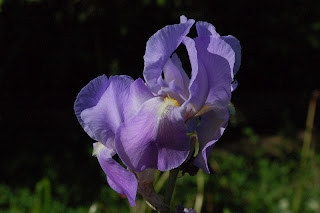One of my favorite flowers is the iris. I had never realized how easy they are to grow.
There are hundreds of varieties of this easy to grow perennial flower. Regular
Irises come in several colors. The Bearded Iris are very popular. Regular Irises make great cut flowers, with their tall, sturdy
stalks. Dwarf varieties grow much smaller, less than eight inches tall. They
are good in flower beds and around rock gardens.
Irises are grown from both seed and root separation. The roots, or Rhizomes,
are easily separated and replanted. The Rhizome looks like a long, thin potato
with roots underneath. When transplanting, separate the Rhizome. Make sure
to have some root and a leaf or two in each section. Plant the Rhizomes near
the surface with the roots below. Space them a foot or so apart . They will
fill in the spaces quickly.
If you want a low maintenance, easy to grow flower, you have come to the
right plant. Irises like full sun, but tolerate partial shade well. Their
only demand is well draining soil to avoid root rot. The soil does not need
to be the richest in your yard. Nor, does it demand heavy fertilizer feeding.Mulching around the plants will help to keep out the weeds. Once established,
you will need to water them only in the driest part of the year. Fertilize
occasionally. Do not apply heavy doses of Nitrogen.When planting, make sure to put it in a spot where it can grow and thrive
for years. It will spread quickly and will need to be thinned or divided
regularly. To divide them, simply pull up some of the Rhizomes. The remaining
plants will reward you with healthier plants and bigger blooms. As for what
to do with the Rhizomes you have culled from your garden....give them to
friends!
Being a hardy plant, Irises are not often bothered by insects. They can suffer
from occasional root borers.
Irises seldom are affected by disease. The most common problem is root rot,
which is caused by poorly draining soils. In preparing beds, make sure soil
is light and well draining. Raise the soil level if need be. Also add sand,
and compost if you have clay soil.
The following pictures are of the iris flowers that I have in my garden.
I plan to plant more this year.
 | ||
| This one is very special to me because it came out of my neighbor's yard after she passed away. |
 | |
| This one I got from Daniel Webster's home when Jorge and I were in New Hampshire. |



No comments:
Post a Comment